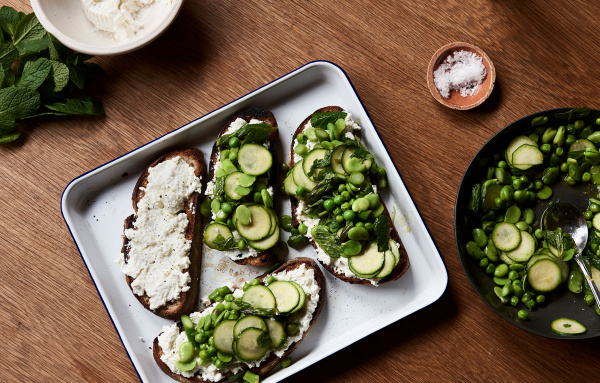All of my childhood memories are in some way linked to food. One of my most vivid memories is seeing lilac and navy blue baskets sitting on the kitchen sink. I would watch my mum fill them with warm curds and the baskets would sit there steaming, fogging up the kitchen window. We would walk a few blocks to our local beach in South Australia and collect seawater. To make ricotta, the Maltese way, this was a necessary step and it was always a day-long process. We would eat the still-warm ricotta on toast drizzled with olive oil, sometimes with sliced tomatoes or with chopped mint and basil.
Spring is a particularly joyous time for food, and my first thoughts jump to the new vegetables which signal the end of winter – peas, asparagus and broad beans. The latter, a staple growing up, are wonderful when young and tender, and double podded to reveal a vibrant green bean. We never ate them like that as children though. Usually picked towards the end of the season when they were large and tough, we would eat them with their outer jacket still on, almost grey in colour once cooked.
I recall sitting on our back step podding hundreds of them with my grandmother and drying them out to last the year. I still occasionally leave the jackets on if they are small beans, for things like spring vegetable stews or more robust dishes, but double podded and only lightly cooked is usually my preference. With peas, fresh ones are only at their best for a day or two after being picked, before the sugars turn to starch and lose much of their sweetness.
If you’re not buying direct from the farmer’s market or growing them yourself, snap-frozen peas are often a better alternative – although the meditative quality of shelling peas is worth it even if they aren’t as sweet as could be! The pods can be boiled with plenty of water to make a stock too, perfect for a pea risotto or adding into soups.
Here, my two childhood foods of ricotta and broad beans are joined with other spring vegetables – peas, asparagus and the first of the zucchini to make a rather simple but incredibly satisfying meal. I’ve served them on slices of toasted sourdough but thin slices of baguette to make them smaller into crostini would be a great alternative, and make for a simple spring dinner party snack. Buffalo ricotta is so incredible if you can find it (usually at good Italian delis). Substitute it with a good quality cow’s milk ricotta is unavailable.

Julia Busuttil Nishimura at home in Brunswick. Photo – Eve Wilson for The Design Files.

The slices of toasted sourdough. Photo – Eve Wilson for The Design Files.

Broad beans were a staple for Julia growing up. Photo – Eve Wilson for The Design Files.

Broad beans were a staple for Julia growing up. Photo – Eve Wilson for The Design Files.

The meditative quality of shelling peas is worth it, tells Julia. Photo – Eve Wilson for The Design Files.

Instead of toast, she also recommends using thin slices of baguette to make smaller crostini as a party snack! Photo – Eve Wilson for The Design Files.

‘Buffalo ricotta is so incredible if you can find it!’ tells Julia. Photo – Eve Wilson for The Design Files.

A simple, seasonal dish for one. Photo – Eve Wilson for The Design Files.


